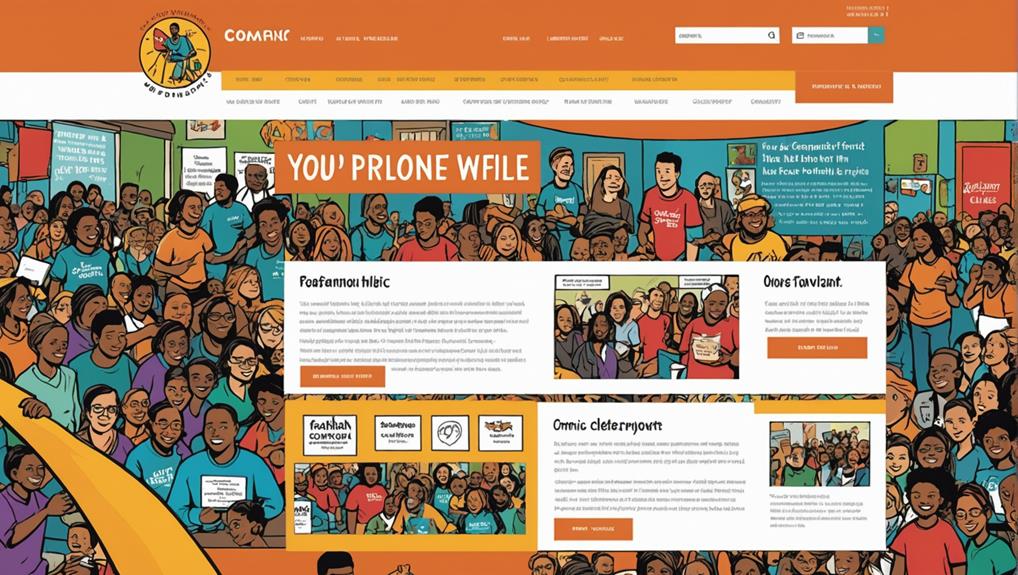
Building a website for your nonprofit can really engage donors and volunteers. Start by sharing emotional stories that connect with people; this helps them feel involved. Make your donation process easy and user-friendly, so supporters don't get frustrated. Highlighting volunteer roles and past experiences encourages new helpers to jump in. It's also important to be transparent, showing how you use donations, which builds trust. Don't forget to optimize for mobile, since many people browse on their phones. With these strategies, your website can become a vibrant hub for support and kindness. There's so much more to discover about crafting the perfect site!
Key Takeaways
- Create a mobile-friendly design to ensure seamless access for users on various devices, enhancing engagement and retention.
- Utilize emotional storytelling and testimonials to foster connections with potential donors and volunteers.
- Implement clear calls to action (CTAs) on donation and volunteer pages to guide users toward desired actions.
- Regularly update content and share impact reports to build transparency and trust with supporters.
- Optimize the website for SEO to increase visibility and attract a broader audience of potential donors and volunteers.
Importance of an Engaging Website

In today's digital age, an engaging website is vital for nonprofits looking to attract and retain donors. Your website is often the first place potential supporters learn about your mission. To grab their attention, you need engaging content that tells your story. Emotional storytelling helps visitors connect with your cause, making them more likely to contribute. Additionally, consider implementing custom brand building services to create a unique identity that resonates with your audience. A well-designed website isn't just about looks; it must also offer a clear and intuitive donation process. This means no complicated forms or hidden fees. Instead, aim for a streamlined donation flow that encourages people to give.
Furthermore, with around 60% of search traffic coming from mobile devices, creating mobile-friendly sites is a must. This guarantees that potential donors can easily navigate your site on the go. Building relationships with your audience is essential. Sharing regular impact reports and transparent financial practices builds trust and confidence in your organization. When donors see the difference their contributions make, they're more likely to support you again. By focusing on these key elements, you can create a digital presence that not only attracts donors but also fosters lasting connections.
Strategies to Attract Donors
To effectively attract donors, nonprofits should focus on creating a compelling online presence that resonates with their audience. Start with an engaging website that tells your story. Use personal narratives to connect emotionally with potential donors. This connection can lead to increased funding opportunities.
Next, make sure your donation pages are user-friendly. Clear calls-to-action (CTAs) and strategically placed donation buttons can greatly improve the experience for visitors. When donors find it easy to give, they're more likely to do so.
Transparency and credibility are essential. Regularly share impact reports and success stories that show how donations make a difference. This builds trust and encourages donors to contribute more generously. Incorporate social proof, like testimonials and endorsements from reputable organizations, to validate your mission.
Volunteer Recruitment Techniques

When you're recruiting volunteers, tailoring your message to connect with their interests is key. Sharing engaging stories from past volunteers can really inspire others to join your cause and see the difference they can make. Plus, if you simplify the application process, more people will feel encouraged to step up and help out!
Tailored Messaging Strategies
Crafting tailored messaging for volunteer recruitment is crucial, as it speaks directly to the unique motivations and priorities of potential volunteers. When you connect with volunteers, you can greatly boost their engagement. Here are a few strategies to reflect on:
- Provide clear information about available volunteer roles, responsibilities, and time commitments.
- Share personal stories and testimonials from current volunteers to show the impact and rewards of getting involved.
- Highlight online opportunities for volunteering, making it easy for individuals to find and join.
- Simplify the application process to guarantee that interested volunteers can easily get started.
Engaging Volunteer Stories
Engaging volunteer stories serve as powerful tools for recruitment, showcasing the transformative experiences individuals can have while contributing to a cause. By sharing stories from current volunteers, you can highlight personal growth and community impact, effectively motivating others to get involved. These success stories make your mission come alive, showing potential volunteers what they can achieve.
To attract engaging volunteers, consider creating a dedicated online presence. This section can outline available volunteer opportunities with clear details about roles, responsibilities, and time commitments. When people see exactly what's expected, they're more likely to participate.
Additionally, use call-to-action campaigns on social media to reach a wider audience. Share compelling testimonials that illustrate real-world impacts, which can inspire others to join your cause. A streamlined application process can also make it easier for people to sign up and start making a difference.
Simplified Application Processes
To attract more volunteers, it is essential to streamline your application process. A simplified application process makes it easy for potential volunteers to engage with your organization. When your website is easy to navigate, it reduces frustrations and encourages more sign-ups. Here are four key elements to evaluate:
- Clear Roles: List specific volunteer positions with responsibilities and time commitments.
- Tailored Messaging: Address the unique motivations of your audience to boost engagement.
- Compelling Testimonials: Share stories from current volunteers about their meaningful experiences.
- Innovative Recruitment Strategies: Utilize online platforms and social media to reach a wider audience.
Essential Website Features
An effective nonprofit website isn't just a digital brochure; it's a powerful tool for outreach and engagement. To truly connect with donors and volunteers, you need vital website features. First, prioritize a mobile-friendly design, as most visitors will likely access your site on their phones. This enhances accessibility and user experience.
Next, focus on clear and compelling calls-to-action (CTAs). Make sure these are easy to spot and use action-oriented language. Phrases like "Donate Now" or "Join Us" guide users effectively toward donations and volunteer sign-ups. Streamlining your donation forms is essential, too. A simple process with minimal steps can lead to more people completing their donations.
Don't forget to showcase engaging testimonials and impactful stories. These can foster trust and create emotional connections, encouraging potential supporters to get involved. Also, keep the content on your site fresh and relevant. Regular updates through blogs or news articles keep visitors coming back and help spread the word.
Enhancing Transparency and Trust

Building trust with your audience goes hand in hand with offering a user-friendly website. When you prioritize transparency, you create an environment where donors and volunteers feel valued and informed. Here are some key ways to enhance trust:
- Share Financial Practices: Openly display your budget and financial reports. This shows you're serious about responsible spending.
- Regular Impact Reports: Provide updates on how donations are used and the achievements made. This keeps everyone in the loop about your nonprofit's progress.
- Use Trust Badges: Feature endorsements from reputable organizations. These badges add credibility and reassure potential supporters of your integrity.
- Highlight Contributions: Celebrate individual and team efforts of your volunteers. Recognizing their hard work fosters a sense of community and trust.
Optimizing for User Experience
Creating a seamless user experience on your nonprofit's website is essential for engaging visitors and encouraging their participation. Since about 60% of search traffic comes from mobile devices, it's vital to design a mobile-friendly site. This means fast loading times and user-friendly navigation. Clear menus help visitors find donation options and sign up for volunteering easily.
You should also use engaging content to keep visitors interested. Regularly updating your site with fresh stories or user-generated content can make it relatable and encourage return visits. Incorporating effective calls-to-action (CTAs) can guide visitors toward important actions, like donating or volunteering. Use action-oriented language and position these CTAs prominently.
Don't forget about website analytics! Tools like Google Analytics allow you to track user behavior. This information helps you see what works and what doesn't, so you can continually optimize your website. Following best practices for search engine optimization (SEO) will also enhance your visibility online. Finally, adding social sharing buttons makes it easy for visitors to share your mission, expanding your reach. By focusing on these elements, you'll create an optimized website that truly engages and inspires your audience.
Frequently Asked Questions
How to Create a Nonprofit Organization Website?
To create a nonprofit organization website, focus on user-friendly design and branding options. Implement a solid content strategy, optimize for SEO, track analytics, and enhance donor engagement through social media and effective volunteer recruitment methods. Regularly maintain your site.
How Do I Create a Donor Website?
To create a donor website, start by enchanting visitors with engaging content. Focus on user experience, mobile optimization, and seamless payment processing. Integrate social media for increased visibility, and implement effective fundraising strategies to boost donor retention.
How Much Does It Cost to Create a Website for a Nonprofit?
Creating a nonprofit website costs between $100 and $15,000. You'll need to plan your budget, compare hosting options, and consider maintenance costs, while focusing on donor engagement and volunteer management through effective content strategy and fundraising tools.
What Is the Cheapest Way for Nonprofits to Accept Donations Online?
Think of your nonprofit as a garden; using donation platforms like PayPal or Stripe minimizes transaction fees. Embrace social media marketing and online events to cultivate donor engagement, recurring donations, and volunteer recruitment while maximizing tax deductions.
Final Thoughts
Building a website for your nonprofit is like planting a garden. With the right care and attention, it can bloom into a vibrant space that attracts donors and volunteers alike. By focusing on engaging content and user-friendly features, you're not just creating a site; you're nurturing a community. Remember, each click can lead to support and inspiration. So, embrace the challenge, and watch your efforts grow into something truly beautiful that makes a difference!
- SEO Content vs. Social Media Content: What’s the Difference? - 23/10/2025
- The Best Types of Content for Service Businesses - 16/10/2025
- How Blogging Drives Leads for Local Businesses - 10/10/2025




